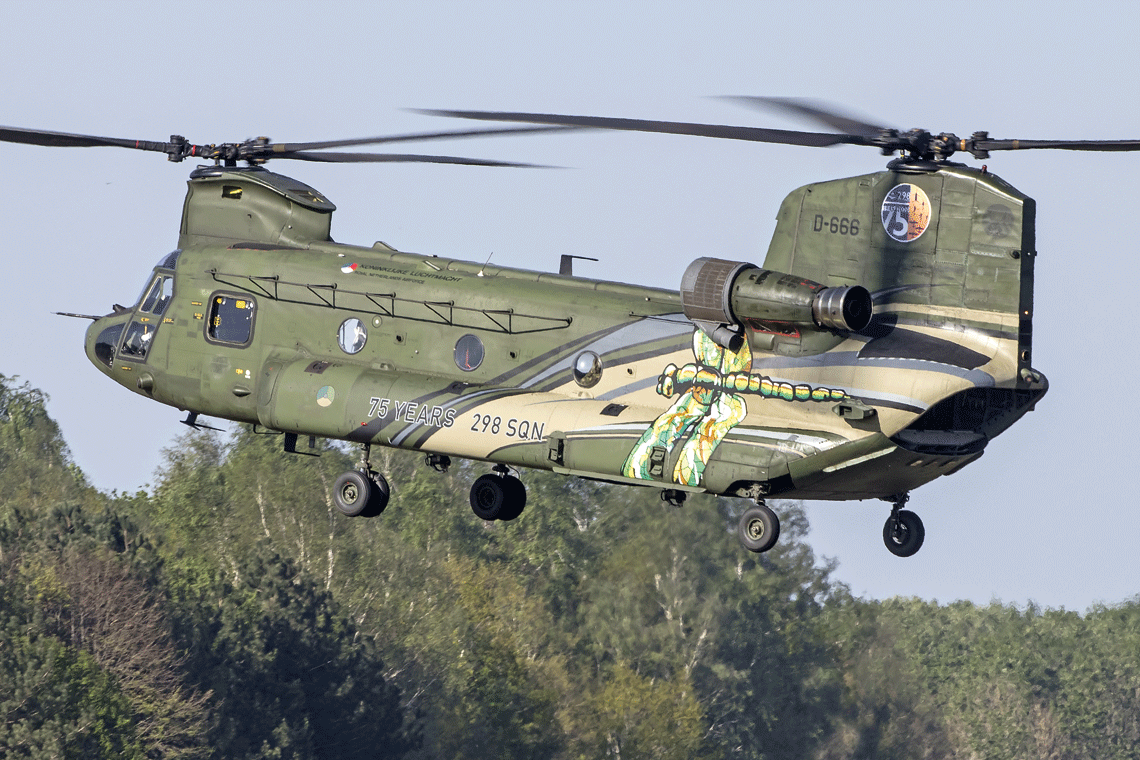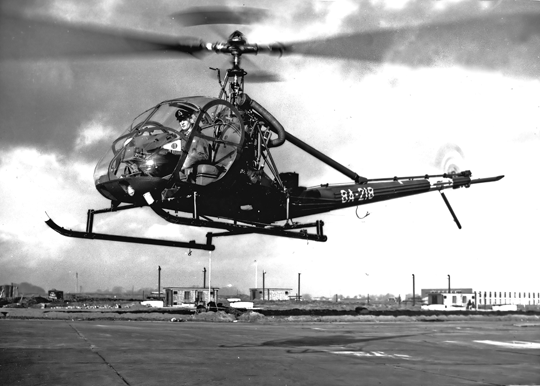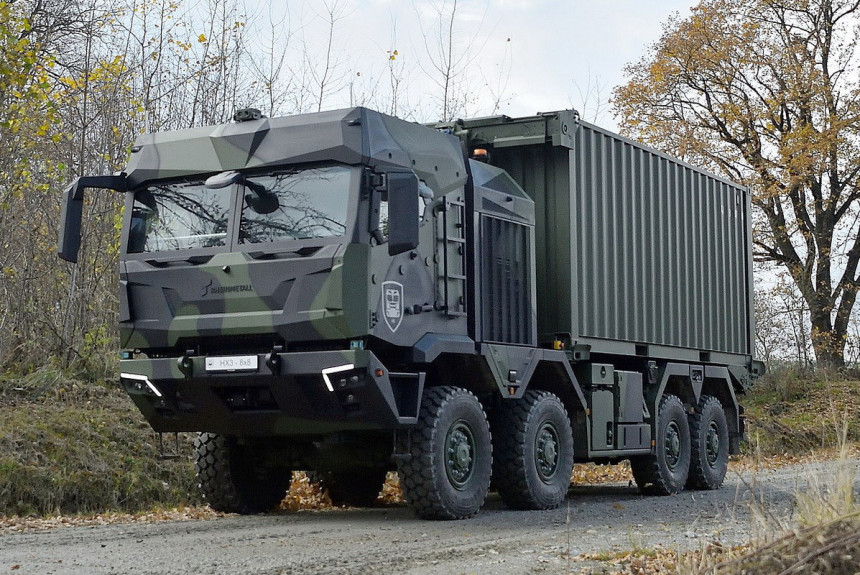
Nothing is too much for us

On the occasion of the anniversary of the 298th squadron, one of the CH-47D helicopters received a special color scheme. On one side is a dragonfly, which is the squad's logo, and on the other side is a grizzly bear, which is the squad's mascot.
This Latin phrase is the motto of No. 298 Squadron of the Royal Netherlands Air Force. The unit reports to the Military Helicopter Command and is stationed at Gilze-Rijen Air Base. It is equipped with CH-47 Chinook heavy transport helicopters. The squadron's history begins in 1944, during World War II, when it was equipped with Auster light reconnaissance aircraft. This is the oldest squadron of the Royal Netherlands Air Force, celebrating its 75th anniversary this year. There are many interesting facts and stories of veterans of the unit associated with it, which can be shared with the readers of the monthly Aviation Aviation International.
In August 1944, the Dutch government suggested that the liberation of the Netherlands by the Allies was imminent. Therefore, it was concluded that a military unit equipped with light aircraft for the transport of personnel and mail was needed, since the main roads, many bridges and railways were badly damaged. Efforts were made to purchase about a dozen aircraft from the Royal Air Force to meet anticipated requirements, and a corresponding contract for 20 Auster Mk 3 aircraft was signed a few weeks later. The machines were delivered to the then Dutch Air company. The power department in the same year. After making the necessary modifications to the Auster Mk 3 aircraft and completing the training of the flight and technical staff, the Dutch Air Force Directorate on April 16, 1945 ordered the formation of the 6th squadron. As the Netherlands was recovering from war damage very quickly, the demand to operate the unit declined rather quickly and the squadron was disbanded in June 1946. Flight and technical personnel and aircraft were transferred to Wundrecht Air Base, where a new unit was created. was created, which was named Artillery Reconnaissance Group No. 1.

The first type of helicopter used by 298 Squadron was the Hiller OH-23B Raven. His introduction to the equipment of the unit took place in 1955. Previously, he flew light aircraft, observing the battlefield and correcting artillery fire.
Indonesia was a Dutch colony. In 1945-1949 there were discussions to determine its future. Immediately after the surrender of the Japanese, Sukarno (Bung Karno) and his supporters in the national liberation movement proclaimed the independence of Indonesia. The Netherlands did not recognize the new republic and a period of difficult negotiations and tense diplomatic activity followed, interspersed with hostilities and armed clashes. Artillery reconnaissance detachment No. 1 was sent to Indonesia as part of the Dutch military contingent in that country. At the same time, on November 6, 1947, the name of the unit was changed to Artillery Reconnaissance Detachment No. 6, which was a reference to the previous squadron number.
When operations in Indonesia ended, No. 6 Artillery Reconnaissance Group was redesignated 298 Observation Squadron and then 298 Squadron on March 1, 1950. the base, which also became the "home" of 298 Squadron. The first commander of the detachment was Captain Coen van den Hevel.
The following year was marked by participation in numerous exercises in the Netherlands and Germany. At the same time, the unit was equipped with new types of aircraft - Piper Cub L-18C light aircraft and Hiller OH-23B Raven and Süd Aviation SE-3130 Alouette II light helicopters. The squadron also moved to Deelen Air Base. When the unit returned to Sosterberg in 1964, the Piper Super Cub L-21B/C light aircraft remained at Deelen, although officially they were still in storage. This made 298 Squadron the first fully helicopter unit of the Royal Netherlands Air Force. This has not changed until now, then the squadron used the Süd Aviation SE-3160 Alouette III, Bölkow Bö-105C helicopters and, finally, the Boeing CH-47 Chinook in several more modifications.
Lieutenant Colonel Niels van den Berg, now commander of 298 Squadron, recalls: “I joined the Royal Netherlands Air Force in 1997. After completing my education, I first flew an AS.532U2 Cougar medium transport helicopter with 300 Squadron for eight years. In 2011, I trained to become a Chinook. As a pilot in 298 Squadron, I quickly became key commander. Later I worked in the Royal Netherlands Air Force Command. My main task was the implementation of various new solutions and I was responsible for several projects implemented by the Royal Netherlands Air Force, such as the future transport helicopter and the introduction of an electronic pilot kit. In 2015, I became the operational chief of the 298th air squadron, now I command a unit.
Tasks
Initially, the main task of the unit was the air transportation of people and goods. Immediately after World War II, the squadron's missions changed to battlefield surveillance and artillery spotting. In the 298s, 23 Squadron operated mainly transport flights for the Dutch Royal Family and communications flights for the Royal Netherlands Land Forces. With the introduction of the OH-XNUMXB Raven helicopters, search and rescue missions were added.
The arrival of the Alouette III helicopters in the mid-298s meant that the number of missions increased and they were now more varied. As part of the Light Aircraft Group, No. 298 Squadron, equipped with Alouette III helicopters, flew missions for both the Royal Netherlands Air Force and the Royal Netherlands Land Forces. In addition to transporting supplies and personnel, 11 Squadron carried out casualty evacuation, general reconnaissance of the battlefield, the transfer of special forces groups and flights in support of the 298th airmobile brigade, including parachute landing, training and retraining. Flying for the Royal Netherlands Air Force, XNUMX Squadron performed personnel transport, VIP transport, including members of the royal family, and cargo transport.
The squadron leader adds: with our own Chinooks, we also support specific units, for example. the 11th Airmobile Brigade and Navy Special Forces, as well as foreign units of NATO allied forces such as the German Rapid Reaction Division. Our highly versatile troop transport helicopters in their current configuration are able to support our partners in a very wide range of missions. At present, we do not have a dedicated version of the Chinook, which means that our tasks do not require any adaptation of the helicopters.
In addition to typical transport tasks, Chinook helicopters are regularly used for the safety of research projects of various Dutch research institutes and for fighting forest fires. When the situation calls for it, special water baskets called "bumby buckets" are hung from Chinook helicopters. Such a basket is capable of holding up to 10 XNUMX. liters of water. They were recently used simultaneously by four Chinook helicopters to extinguish the largest natural forest fire in the history of the Netherlands in De Piel National Park, near Dörn.
Humanitarian actions
Everyone who serves in the Royal Netherlands Air Force wants to take part in humanitarian missions. As a soldier, but above all as a person. The 298th squadron has repeatedly taken an active part in various humanitarian operations, starting from the turn of the sixties and seventies.
The winter of 1969–1970 was very difficult for Tunisia due to heavy rains and resulting floods. A Dutch Crisis Brigade was sent to Tunisia, made up of volunteers selected from the Royal Netherlands Air Force, the Royal Land Forces and the Royal Netherlands Navy, who were on standby to carry out humanitarian relief operations. With the help of Alouette III helicopters, the brigade transported the wounded and sick and checked the water level in the Tunisian mountains.
1991 was marked by the first war in the Persian Gulf. In addition to the obvious military aspects, the anti-Iraqi coalition also saw the need to solve humanitarian problems. Coalition forces launched Operation Heaven and Provide Comfort. These were relief efforts of unprecedented magnitude, aimed at delivering goods and humanitarian aid to refugee camps and repatriating refugees. These operations involved 298 Squadron as a separate 12-man unit operating three Alouette III helicopters between 1 May and 25 July 1991.
In the following years, 298 Squadron was mainly involved in various military operations, as well as in stabilization and humanitarian activities carried out under the auspices of the United Nations.
